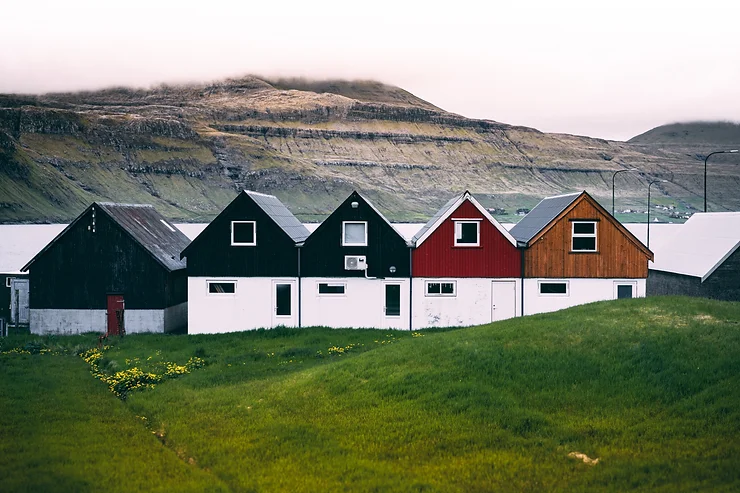Eco-Friendly Homes in Wales: How Green Building is Shaping the Market

Setting the Scene
As real estate investment continues to thrive in Wales, there is a palpable shift in consciousness towards environmental issues. The pristine landscapes and natural beauty that define Wales have fostered a deep appreciation for the environment among its residents. This growing awareness has led to a significant change in the way people approach real estate investment.
One concept that has gained remarkable prominence in recent years is that of eco-friendly homes. These homes are designed and built with a focus on minimizing their environmental impact. Their significance lies in their ability to harmonize modern living with ecological responsibility. As real estate investors and homebuyers seek properties that align with their environmental values, eco-friendly homes have emerged as a compelling choice.
At the heart of this shift towards eco-friendly real estate investment are green building practices. These practices emphasize sustainability, energy efficiency, and reduced carbon footprints. They offer not only a solution to the pressing environmental concerns but also a promising avenue for real estate investors looking to make a positive impact on both the environment and their investment portfolios. In this article, we delve deeper into the green building revolution and its transformative role in shaping the Welsh real estate market.
The Green Building Revolution
The green building revolution in Wales represents a remarkable shift in property investment practices. To understand its significance, it’s crucial to explore its history and evolution. In recent decades, Wales has witnessed a growing commitment to environmental sustainability in the construction industry. This journey began with the recognition of the adverse effects of conventional building practices on the environment.
Key milestones have marked the adoption of eco-friendly construction methods. Wales started embracing green building principles through the promotion of energy-efficient designs and eco-conscious materials. The introduction of sustainability standards, such as BREEAM (Building Research Establishment Environmental Assessment Method), played a pivotal role in encouraging eco-friendly property investment in Wales
Benefits of Eco-Friendly Homes
Eco-friendly homes offer a myriad of advantages for property investment in Wales. Firstly, they contribute significantly to sustainability by reducing the carbon footprint associated with traditional construction. These homes incorporate energy-efficient systems, such as solar panels and insulation, which not only minimize environmental impact but also lead to substantial cost savings for homeowners.
Living in eco-friendly homes promotes energy efficiency, resulting in lower utility bills. Additionally, the use of sustainable materials enhances indoor air quality and occupant comfort. Furthermore, eco-friendly homes are future-proof investments, as they tend to appreciate in value due to increasing demand for environmentally responsible living spaces.
In this era of property investment in Wales, eco-friendly homes stand out as a wise choice for both investors and homeowners, offering a harmonious blend of environmental responsibility, financial benefits, and sustainable living.
Eco-Friendly Technologies
Eco-friendly technologies are at the forefront of the green building revolution in Wales, shaping the landscape of property bond investments. These innovative technologies encompass a range of sustainable practices and materials, all aimed at reducing the environmental impact of construction and enhancing the energy efficiency of homes.
One key area of focus in green building is insulation. Advanced insulation materials and techniques ensure that homes retain heat during the winter and stay cool in the summer. This not only enhances the comfort of residents but also significantly reduces energy consumption for heating and cooling, making properties more cost-effective and attractive for property bond investments.
Another critical aspect is the integration of energy-efficient appliances. Smart thermostats, LED lighting, and energy-efficient HVAC systems are just a few examples of technologies that minimize energy wastage, resulting in lower utility bills for homeowners and higher property values for investors. These advancements are reshaping the way people perceive eco-friendly homes, positioning them as practical choices for property bond investments.
Furthermore, renewable energy sources play a pivotal role in green building. Solar panels, wind turbines, and geothermal heating systems are increasingly integrated into eco-friendly homes, providing a sustainable source of energy and reducing reliance on fossil fuels. This not only reduces environmental impact but also contributes to long-term savings for homeowners, making such properties highly appealing for property bond investments.
As eco-friendly technologies continue to evolve and become more accessible, they are driving a transformative change in the Welsh real estate market. Property bond investors who recognise the potential of these technologies are not only contributing to a greener future but also positioning themselves for financial success in an increasingly eco-conscious market.

Architectural Design and Sustainability
Architectural design plays a pivotal role in the creation of sustainable homes, reshaping the landscape of eco-friendly properties in Wales. Sustainable architectural design goes beyond aesthetics; it prioritizes functionality, energy efficiency, and the minimization of environmental impact.
One key aspect of sustainable design is the strategic use of natural light and ventilation. Well-placed windows, skylights, and open floor plans maximize natural lighting, reducing the need for artificial lighting during the day. This not only lowers energy consumption but also creates a healthier and more pleasant living environment for residents.
Eco-conscious architects also prioritize insulation and thermal mass. Proper insulation ensures that homes are well-sealed and maintain a consistent temperature, reducing the need for excessive heating or cooling. Additionally, the use of materials with high thermal mass, such as concrete or stone, helps regulate indoor temperatures, further enhancing energy efficiency.
Innovative roofing designs are another example of sustainable architectural elements. Green roofs, covered in vegetation, provide natural insulation and absorb rainwater, reducing runoff and supporting local ecosystems. Similarly, rainwater harvesting systems integrated into the architectural design allow homeowners to use rainwater for irrigation and other non-potable purposes.
Overall, sustainable architectural design transforms eco-friendly homes in Wales into efficient, comfortable, and environmentally responsible living spaces. These design elements not only enhance the quality of life for residents but also contribute to the broader sustainability goals of Wales while making such properties increasingly attractive in the real estate market.
Wales’ Commitment to Green Building
Wales has demonstrated a strong commitment to green building, aligning its policies with the global imperative for sustainability. The government of Wales has introduced a series of policies and incentives that actively support eco-friendly construction practices. These initiatives not only reflect the country’s dedication to environmental responsibility but also shape the landscape of portfolio property management in Wales.
One notable policy is the “Future Generations Act,” which places a legal duty on public bodies to consider the long-term impact of their decisions on future generations. This legislation encourages the adoption of sustainable building practices that benefit both current and future residents. Additionally, the Welsh government has introduced financial incentives, such as grants and tax incentives, to promote green building and energy efficiency measures.
Local initiatives and regulations further promote eco-friendly construction. For instance, the “One Planet Development Policy” encourages sustainable land use and green building in rural areas. Moreover, the incorporation of sustainable design principles, like BREEAM standards, has become common in many local planning regulations.

Challenges and Solutions
While green building projects in Wales hold great promise, they are not without their challenges. Common hurdles include higher upfront costs, the need for specialized knowledge and skills, and resistance to change in the construction industry.
To overcome these challenges, property portfolio management professionals can consider several strategies. Firstly, financial challenges can be addressed through innovative financing options, such as green bonds or energy performance contracts, which can help offset initial costs and provide long-term savings.
Secondly, building a knowledgeable workforce is essential. Training and upskilling employees in sustainable construction practices ensure that projects are executed effectively. Collaboration with green building experts and professionals can provide valuable insights and guidance.
Lastly, addressing resistance to change requires effective communication and education. Property portfolio managers can engage stakeholders through awareness campaigns, demonstrating the long-term benefits of eco-friendly properties, including energy cost savings and increased property values.
By proactively addressing these challenges and leveraging the support of government policies and incentives, property portfolio management in Wales can play a significant role in advancing the green building movement and shaping a more sustainable future for the real estate market.
Case Studies: Green Homes in Wales
To illustrate the impact of green building in Wales, let’s delve into real-life examples of eco-friendly homes that have reshaped the landscape of investment property sourcing in the country. These homes represent the epitome of sustainable living and serve as inspiring models for the industry.
One remarkable green home in Wales showcases cutting-edge solar panel technology. Its rooftop solar array not only powers the entire household but also generates surplus energy, which is fed back into the grid, resulting in substantial savings for the homeowner. This not only makes the property energy-efficient but also financially savvy.
Another standout example features innovative rainwater harvesting and greywater recycling systems. These eco-conscious solutions not only reduce water bills but also minimize the environmental impact of water usage. By reusing rainwater and treated greywater for irrigation and flushing toilets, this home exemplifies sustainable water management practices.

Consumer Perspective
The perspectives of homeowners who have embraced eco-friendly living in Wales provide invaluable insights into the motivations driving the green building movement. Many homeowners are drawn to green homes not only for their environmental benefits but also for the enhanced quality of life they offer.
These individuals share a common motivation: the desire to reduce their ecological footprint. By choosing eco-friendly homes, they contribute to environmental preservation and inspire others to do the same. Additionally, the financial benefits, such as reduced utility bills and potential property value appreciation, are compelling reasons for their choice.
From a personal perspective, homeowners who opt for green homes often express a sense of fulfillment in living harmoniously with nature. They relish the healthier indoor environments, abundant natural light, and energy efficiency that green homes offer. Their experiences serve as testimonials to the transformative power of eco-friendly living and inspire others to consider investment property sourcing in the realm of green building.
The Future of Green Building
The future of eco-friendly homes in Wales holds immense promise. As sustainability becomes an integral part of property investment strategies, we can anticipate several trends and innovations in the green building industry. First, we expect to see a surge in net-zero energy homes, where properties generate as much energy as they consume, making them not only eco-friendly but also energy-independent. Second, advancements in smart home technology will further enhance energy efficiency and control. Lastly, the integration of circular economy principles will lead to more sustainable building materials and practices, reducing waste and environmental impact.
Eco-Friendly Homes and Market Dynamics
The impact of green building on the Welsh property market is profound. Eco-friendly features have become significant drivers of property values and demand. Homes with green credentials not only command higher prices but also enjoy shorter time on the market. As sustainability gains importance in the eyes of property investors, the market dynamics are shifting in favor of eco-friendly properties.
Moreover, the demand for green homes aligns with the broader shift in consumer preferences towards eco-conscious living. As more buyers prioritize sustainability, the demand for eco-friendly homes is expected to remain strong.
The green building movement is not just a trend; it’s a transformation of the property market, influencing the decisions of investors and homeowners alike. Property bonds for eco-friendly developments are becoming increasingly attractive, offering a blend of financial returns and environmental responsibility.
Conclusion
In conclusion, the rise of eco-friendly homes in Wales is reshaping the property market and redefining investment strategies. The commitment to sustainability, driven by government policies, incentives, and consumer awareness, positions green building as the future of property investment. As we look ahead, the prospects for eco-friendly homes are bright, with innovations, trends, and market dynamics all aligning in favor of environmentally responsible property investment. The significance of green building in Wales extends beyond financial returns—it represents a commitment to a sustainable and greener future for all. Property bonds for eco-friendly developments hold the promise of a brighter and more sustainable tomorrow.






